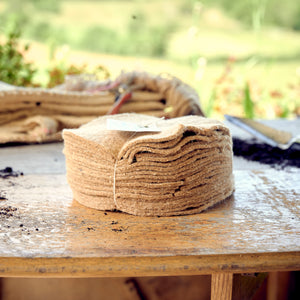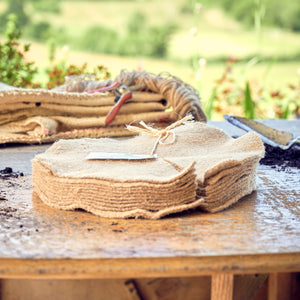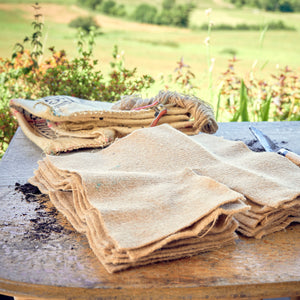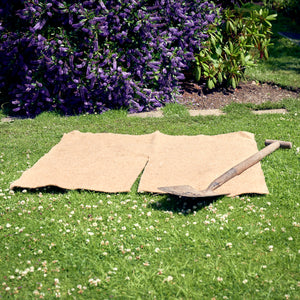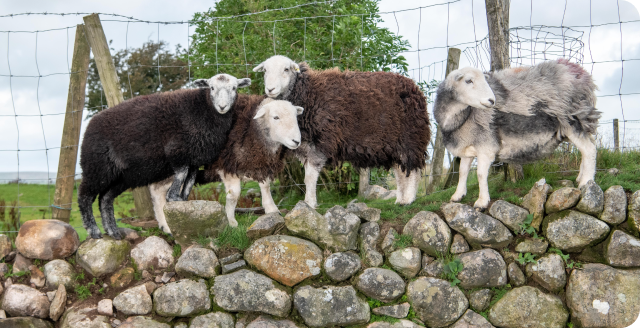Worms are brilliant at tidying things up. Put your kitchen scraps in the composter, let them rot down a little, and worms in the soil will find their way in and eat up the waste. They actually eat the bacteria that eats the waste, so there’s a whole food-chain going on in there! Some wormeries involve harvesting the “tea” to use as a liquid fertiliser but this system is a means of reducing your household waste and enriching the surrounding soil. Every few months or so there will be an accumulation of compost that you can scoop out and use as a lovely rich potting compost.
A lot of the worm farms on the market are plastic, and tend to be ones you keep indoors or above ground and faff on with adding worm bedding and harvesting tea and attending to the wigglers. This worm composter is a natural, breathable composting system made from terracotta. It provides an eco-friendly way to compost kitchen scraps and reduce the amount of food waste you throw away. Did you know that waste food that's thrown in the bin creates methane gas? Composting food waste reduces this, by exposing the throwaway food to oxygen, which prevents methane-producing microbes from becoming active. In case you didn't know, methane is a greenhouse gas that is 28 times more potent than CO₂!
Apart from being a rather pleasing shape, there are some functionality features of a terracotta worm composter that make it perform better than plastic ones:
-
Breathability – the porous nature of terracotta allows air circulation, preventing odour build-up and regulating moisture.
-
Temperature regulation – terracotta helps maintain a stable internal temperature, keeping worms comfortable.
-
Encourages worms from the local environment, rather than introducing worms that have been bred overseas and shipped over here.
-
Eco-friendly – made from natural clay, they are biodegradable and don’t release microplastics.
-
Moisture control – the terracotta absorbs excess moisture, reducing the risk of a soggy compost environment.
-
Odour control – if the food waste gets soggy it can smell, so the terracotta helps to regulate this.
Worms are brilliant at tidying things up. Put your kitchen scraps in the composter, let them rot down a little, and worms in the soil will find their way in and eat up the waste. They actually eat the bacteria that eats the waste, so there’s a whole food-chain going on in there! Some wormeries involve harvesting the “tea” to use as a liquid fertiliser but this system is a means of reducing your household waste and enriching the surrounding soil. Every few months or so there will be an accumulation of compost that you can scoop out and use as a lovely rich potting compost.
A lot of the worm farms on the market are plastic, and tend to be ones you keep indoors or above ground and faff on with adding worm bedding and harvesting tea and attending to the wigglers. This worm composter is a natural, breathable composting system made from terracotta. It provides an eco-friendly way to compost kitchen scraps and reduce the amount of food waste you throw away. Did you know that waste food that's thrown in the bin creates methane gas? Composting food waste reduces this, by exposing the throwaway food to oxygen, which prevents methane-producing microbes from becoming active. In case you didn't know, methane is a greenhouse gas that is 28 times more potent than CO₂!
Apart from being a rather pleasing shape, there are some functionality features of a terracotta worm composter that make it perform better than plastic ones:
-
Breathability – the porous nature of terracotta allows air circulation, preventing odour build-up and regulating moisture.
-
Temperature regulation – terracotta helps maintain a stable internal temperature, keeping worms comfortable.
-
Encourages worms from the local environment, rather than introducing worms that have been bred overseas and shipped over here.
-
Eco-friendly – made from natural clay, they are biodegradable and don’t release microplastics.
-
Moisture control – the terracotta absorbs excess moisture, reducing the risk of a soggy compost environment.
-
Odour control – if the food waste gets soggy it can smell, so the terracotta helps to regulate this.
How the Terracotta Worm Composter Works
The holes at the base let worms from the soil in. It also lets them out, along with nutrients that they deliver to other parts of the garden. The holes permit fluid to percolate out. Worms need air, so the design of the pot, along with the holes, lets air in to circulate. Er, that’s it really. It’s pretty simple. That’s the sort of thing we like: simple but effective.
How to Maintain the Terracotta Worm Composter
If it’s looking a bit wet, add some layers of dry stuff along with the kitchen scraps to balance moisture and prevent odour. Avoid overfilling the composter, as too much food can cause odours, attract pests, and restrict the amount of air, which means the worms can’t operate as efficiently as they would like to. If you find you’ve got more compost than space, put another one in another part of the garden. You can toggle between the two - you'll be pleasantly surprised by how quickly the waste goes down!
Harvest the compost every few months, remove the finished compost and use it in the garden or for your houseplants.






